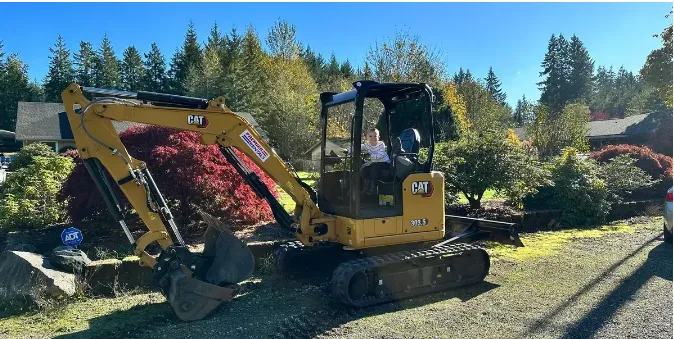
The Real Cost of Full Site Preparation near Kitsap County, WA
If you’re standing on a raw lot in Kitsap County and wondering, “How much is it going to take to make this build-ready?”—you’re not alone. You might feel excited, but also worried. Maybe you’ve heard stories about surprise costs, delays after a rainstorm, or a bid that looked simple but doubled once work started. At TH Excavation, based in Port Orchard and serving Kitsap, Pierce, Mason, and Thurston Counties, we meet homeowners like you every week. You want straight answers, a clear plan, and no games. That’s exactly what this guide is for: to help you understand the real cost of full site preparation—not just the number at the bottom of a bid, but the conditions, choices, and small details that raise or lower that number.
We’ll walk you through the work that’s included, the line items that matter, the hidden costs people miss, and how Kitsap County’s unique soil and weather shape your budget. No scare tactics. No fluff. Just the truth you need to make smart decisions and build with confidence.

Who This Guide Helps: Kitsap County Homeowners Planning to Build
This guide is for homeowners who are:
Building a custom home, ADU, shop, or manufactured home pad.
Turning a wooded or sloped lot into a safe, build-ready site.
Working through questions about permits, utilities, drainage, and access.
Comparing bids and trying to avoid change orders and delays.
If that sounds like you, keep reading. We’ll give you a framework for planning, budgeting, and choosing the right team.
Full Site Preparation Explained: What It Includes and Why It Matters
“Full site preparation” means getting your land ready for construction—safely, legally, and in a way that protects your future home. Typical scope includes:
Clearing and grubbing: removing brush, trees, stumps, roots.
Earthwork and grading: shaping the land for the foundation, access, and drainage.
Excavation: digging for footings, utilities, septic components if applicable.
Driveway and access: creating stable, drivable access for equipment and deliveries.
Drainage and erosion control: managing water with swales, ditches, culverts, and silt fences.
Utilities: trenching and backfilling for power, water, sewer or septic, communications.
Import/export of materials: bringing in crushed rock, structural fill, or hauling unsuitable soils away.
Done right, site prep prevents future problems like foundation cracks, standing water, and roadway washouts. Done wrong, it becomes a long, expensive fight against nature.
Kitsap County Cost Snapshot: Typical Ranges for Site Prep Work
Every lot is different, but here’s how costs tend to behave:
Light clearing, gentle slope, good access: lower end.
Moderate clearing, some slope, limited access: mid-range.
Heavy timber, steep slope, poor soils, long driveway: higher end.
Your cost isn’t only about “how many hours on a machine.” It’s about the conditions under the grass and the water in the sky. That’s why the best bids start with a site walk, soil understanding, and clear assumptions in writing.
Line-Item Breakdown: Clearing, Grading, Utilities, Drainage, and Access
Think of your budget like a pie. These are the slices that matter.
1) Clearing & Grubbing
Chainsaws, excavators, and stump grinders.
Root balls and stumps can run bigger and deeper than they look.
Haul-off and disposal are often separate line items.
2) Earthwork & Grading
Cutting high spots, filling low spots, and compacting.
Proper grading protects your slab or crawlspace and keeps water flowing away.
Compacting in lifts matters more than “moving a lot of dirt fast.”
3) Utilities
Trenching for power, water, sewer or septic, and communications.
Deeper trenches, longer runs, and rock in the trench raise the cost.
Locates are required; markouts protect everyone.
4) Drainage & Erosion Control
Swales, rock checks, culverts, and outlet protection.
Silt fence to keep soil from leaving your site.
In rainy seasons, erosion control can become a major line item.
5) Driveway & Access
Clearing, base rock, geotextile fabric, and culverts at ditches.
Mobilization: getting machines in and out of the site safely.
Tight access often means smaller machines and more time.
6) Materials & Trucking
Crushed rock, structural fill, pipe, fabric, and culverts.
Trucking distance and fuel affect delivered costs.
Exporting unsuitable soils can be a budget swing.
Hidden Costs Most Homeowners Miss in Kitsap County
Here are the sneaky ones:
Soft or saturated soils: You may need undercut and structural fill.
Stump and root webs: A single big stump can hide a mess underground.
Rock in trenches: Slows production and can require different equipment.
Long utility runs: The farther your power and water, the more time and material.
Rain delays and re-work: Poor erosion control today becomes repair work tomorrow.
Access damage: If delivery trucks rut a fresh driveway, repairs add up.
Good planning and honest site walks pull these out of the shadows before they hit your wallet.
Permits, Fees, and Inspections in Kitsap County (What to Budget For)
Permits and inspections are not “nice to have.” They’re required and they protect you. Expect line items for:
Clearing/grading permits based on scope.
Right-of-way/driveway permits if connecting to county roads.
Stormwater measures that must be installed and maintained.
Inspections tied to grading, utilities, and erosion control.
We help you understand what applies to your lot and coordinate the timing so crews aren’t waiting on paperwork.
Soil, Slope, and Rain: How Western Washington Conditions Change the Price
Kitsap County’s mix of glacial till, clay pockets, and steady rain is a puzzle. Here’s how it hits the budget:
Soil: Clay holds water; till can be rocky. Either one can slow trenching and compaction.
Slope: Steeper lots can need retaining, additional cuts/fills, or longer drives.
Rain: Wet ground reduces production and increases the need for erosion control.
The takeaway: timing matters (more on that below), and so does a plan for water.
Tree and Stump Removal: Methods, Haul-Off, and Disposal Costs
Trees look beautiful until you have to remove them. Costs depend on:
Species and size: Cedar and fir stumps can be stubborn.
Count and spacing: Many medium stumps can take longer than a few giants.
Haul-off vs. on-site solutions: Chipping, grinding, or burning (where allowed) changes the numbers.
Access for equipment: Tight spaces mean more hand work and time.
We’ll discuss whether it’s smarter to chip and spread, grind in place, or haul off—each choice has a cost and a benefit.
Erosion Control and Stormwater: Keeping Sediment Out and Costs Down
Water goes where gravity sends it. Your job is to guide it:
Silt fence to stop sediment leaving the property.
Check dams and rock blankets in swales to slow flow.
Construction entrances (rock pads) to keep mud off public roads.
Temporary ditches and culverts that protect new work from washouts.
Every dollar spent on erosion control saves multiple dollars on re-work and fines. It also keeps your neighbors happy.
Driveway and Access Planning: Mobilization, Rock, and Maintenance Costs
Access is not just “a way in.” It’s your project’s bloodline:
Geotextile fabric and base rock keep trucks from sinking.
Culverts at roadside ditches allow safe entry without flooding the shoulder.
Turnouts give delivery trucks space to maneuver.
Cut corners here and you’ll pay for it again and again.
Utilities 101: Locates, Trenching, Water, Power, and Communications
Before a bucket hits the dirt, utilities must be located. Then:
Depth and separation requirements guide trench size and layout.
Bedding and backfill protect lines from rock and voids.
Conduit and sweeps for power and communications save headaches later.
Testing and inspections confirm it’s done right the first time.
If you’re on sewer, plan for depth and slope. If you’re on septic, read the next section.
Septic vs. Sewer in Kitsap County: Design, Install, and Cost Impacts
For many rural and semi-rural lots:
Septic requires a designed system, soil testing, and proper setbacks.
Drainage planning around the drainfield is essential—no roof water onto the field.
Access routes must allow for tank delivery and future maintenance.
On sewer? Great—you still need trenching, bedding, and backfill, and you may need road crossing or connection fees. Either way, plan it early so we can integrate utilities and grading without re-digging.
Season and Timeline: The Best Time to Start Site Prep in Western Washington
You can build year-round, but drier months make everything easier:
Spring to early fall usually means better production, fewer delays, and cleaner compaction.
In wetter months, budget for more erosion control, pumping, and weather-related adjustments.
If your timeline is tight, we phase tasks to keep momentum: access first, then clearing, then earthwork, utilities, and drainage.
DIY vs. Hiring Pros: Real Risks, Real Numbers, and Insurance Gaps
We get the DIY itch. But consider:
Liability: Hitting a utility line or damaging a roadway can get expensive fast.
Production: A weekend on a rental machine rarely matches a pro crew’s output.
Quality: Compaction, slope, and drainage aren’t guesswork—your foundation depends on them.
If you want to DIY a part (such as light brush clearing), let’s talk about where it makes sense and where it doesn’t.
How to Read Bids: Apples-to-Apples Comparisons That Protect Your Budget
A fair bid is clear and complete. Look for:
Scope in plain English with inclusions and exclusions.
Material types and quantities (rock class, fabric, pipe sizes).
Assumptions (soil type, stump count, trench lengths).
Unit rates for extra work (per hour, per load, per ton).
Contingency plan if site conditions differ from assumptions.
If one bid is much lower, it may be missing the things that become change orders later.
Change Orders and Contingency: Preventing Surprises Before They Happen
Change orders aren’t “gotchas.” They’re how we handle unknowns. The trick is to reduce the unknowns:
Site walk and soil info before bidding.
Probing and test pits where conditions are unclear.
Clear allowances for rock, export, or extra erosion control.
We suggest building a 10–15% contingency into your budget for the unexpected. If you don’t need it, great.
Budget Planning: Phasing, Cash Flow, and Financing Options
Smart phasing keeps cash flow steady:
Access and erosion control so the site can handle deliveries.
Clearing and grubbing to define pad and utility routes.
Grading and utilities to set elevations and service your build.
Final shaping and rock to lock in access and drainage.
We can also help you break the project into milestones with clear invoices tied to real progress.
How TH Excavation Tailors Site Prep to Your Lot and Your Plans
Every site is different. Our approach is simple:
Listen first: your goals, your budget, your timeline.
Walk the site: identify risks, access, and soils.
Map the scope: drawings or simple sketches—whatever helps you see the plan.
Write it down: a clear, transparent bid with assumptions listed.
Build it right: safety, quality, and open communication from start to finish.
We’re local to Port Orchard, and we work across Kitsap, Pierce, Mason, and Thurston. That regional experience helps us predict issues and keep your project moving.
Mini Case Studies: What Drove Costs Up (and Down) on Local Projects
Case A: The Soaked Slope
A hillside lot looked straightforward—until winter rain arrived. We added extra erosion control, staged excavation, and installed temporary drainage. It cost more up front, but it saved the driveway from washing out and protected the future foundation.
Case B: The Long Utility Run
The home site sat 500 feet from the road. We planned trenching and conduit together, scheduled inspections in one block, and used fabric and rock to protect backfill. Doing it once, the right way, kept the budget tight.
Case C: The Stump Surprise
A “lightly wooded” site hid a network of stump roots. Because our bid included an allowance and unit rates, the owner could approve the extra work with full visibility—and without derailing the timeline.
Homeowner Prep Checklist: What to Do Before We Break Ground
Survey in hand: property lines and proposed house location.
Basic topography: even a simple elevation sketch helps.
Utility plan: septic vs. sewer, water source, and power route.
Access confirmed: gates unlocked, neighbors informed if needed.
Budget with contingency: set aside 10–15% for unknowns.
Decision maker available: quick answers keep production rolling.
A little prep from you saves a lot of time in the field.
Questions to Ask Any Site Prep Contractor in Kitsap County
What’s included—and excluded—in your scope?
How do you handle unsuitable soils or rock if we find them?
What erosion control will you install and maintain?
Can I see material specs (rock, fabric, pipe) in the bid?
How do you schedule inspections to avoid downtime?
What are your unit prices for extra work if conditions change?
Who will be my point of contact during the job?
Good contractors like clear questions. It shows you care about a clean project.
Pierce, Mason, and Thurston Counties: What Changes Outside Kitsap
Every county has its own flavors:
Pierce: More urban pockets can mean tighter access and stricter right-of-way rules.
Mason: Rural parcels and timber lots often mean longer drives and more clearing.
Thurston: Flat ground is common, but drainage rules still matter a lot.
Our process doesn’t change: walk the site, plan for water, confirm utilities, and keep you informed.
Next Steps: Get a Clear Plan and a Transparent Estimate from TH Excavation
If you’re ready to turn your lot into a build-ready site, let’s walk it together. We’ll listen to your goals, map the work, and give you a clear, line-by-line estimate with honest assumptions and unit rates for unknowns. No guesswork. No surprises. Just a solid plan built for Kitsap County conditions—and your timeline.
TH Excavation
Based in Port Orchard, Kitsap County, WA
Serving Kitsap, Pierce, Mason, and Thurston Counties
When you’re ready, we’ll be there—with a plan that makes sense and a crew that treats your project like our own.

